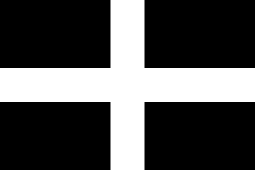Bucca (mythological creature)
| Grouping |
Mythological creature Fairy Sprite |
|---|---|
| Country | United Kingdom |
| Region | Cornwall |
Bucca is a fairy in Cornish folklore that was believed to be a spirit that inhabited mines and coastal communities as a hobgoblin during storms. The mythogological creature is linked to the Púca from Irish and Welsh folklore. Rev W. S. Lach-Szyrma, one 19th-century writer on Cornish antiquities, suggested the Bucca had originally been an ancient pagan deity of the sea, though his claims are mainly conjecture.[1]
Neopagan groups, principally the Witchcraft coven of Ros An Bucca, have begun to acknowledge the Bucca in their rites.[2]
In the children's book Thomas and the Tinners by Jill Paton Walsh, Buccas have become fairies who work in Cornish tin mines, granting wishes in exchange for food (see knockers).
Folklore
In 1611, in the Cornish language book the Creation of the World the Bucca is mentioned and some believe that the word is a borrowing into Cornish from Old English 'puca'. A cognate form in Welsh is of similar non-Brythonic Celtic origin, demonstrated in Cornish by the middle 'cc' which does not occur in Brythonic Celtic. According to the Oxford English Dictionary pwca is ultimately of Scandinavian origin.
In 1890, the Cornish folklorist William Bottrell stated that:
- It is uncertain whether Bucka can be regarded as one of the fairy tribe; old people, within my remembrance, spoke of a Bucka Gwidden and a Bucka Dhu - by the former they meant good spirit, and by the latter an evil one, now known as Bucka boo. I have been told, by persons of credit, that within the last forty years it was a usual practice with Newlyn and Mousehole fishermen to leave on the sand at night a portion of their catch for Bucka. Probably from this observance the common nickname of Newlyn Buckas was derived. An old rhyme says:
- 'Penzance boys up in a tree,
- Looking as wisht(i.e. haunted) as wisht can be;
- Newlyn buckas as strong as oak,
- Knocking them down at every poke.'
In keeping with Bottrell's findings, various folkloric investigations around the same time that Bucca seems to have featured in two forms, Bucca Widn (White Bucca) and Bucca Dhu (Black Bucca). Bucca also seems to associated with the wind, in Penzance it was customary to refer to storms that emanated from a south westerly direction, as "Bucca calling", sailors and fishermen also believe that Bucca's voice carried on the wind. Bucca was also sometimes referred to as a tin mining spirit which may indicate a wider fertility origin than that of the sea.
Also in the 19th century, there were reports of fishermen venerating Bucca with offerings. These included food offerings, particularly of fish, given to Bucca on beaches.[3] One such beach used for this purpose was the area of Newlyn known formerly as Park an Grouse (in Cornish meaning 'the field of the cross') where a stone cross was allegedly once situated. Similar offerings were recorded on the beaches of Mousehole and Newlyn "Town" (the area now known as Newlyn Cliff).[4][5]
During the 18th and 19th centuries, folklorists generally interpreted the popular beliefs and practices they found as survivals from or relics of Catholicism, equating such 'survivals' with Paganism. Some also saw the continuation of practices from pre-Christian times. This idea has been discredited in recent years by academic folklorists.[6] although this notion persists in the popular imagination. There is little surprise that the Reverend W. S. Lach-Szyrma should have interpreted Bucca as the "storm god of the old Cornish", equating this figure with the Devil.[7]
In the 19th century a new road was built between Penzance and Land's End and the Tolcarne River (main stream at the outskirts of Newlyn) was bridged; this area was called Bucca's pass.
References
- ↑ W.S. Lach-Szyrma, “Notes from Cornwall” The Antiquary 10 (1884), p. 264.
- ↑ Gary, Gemma (2008) Traditional Witchcraft: a Cornish book of ways. Troy Books
- ↑ Evans-Wentz, W. Y. (1911) The Fairy-Faith in Celtic Countries
- ↑ William Bottrell, Traditions and Hearthside Stories of West Cornwall, 1870–90, vol.2
- ↑ http://www.freefictionbooks.org/books/t/48871-traditions-and-hearthside-stories-of-west-cornwall
- ↑ Dorson, Richard M., The British Folklorists, (1968/1999), see especially chapters 1, 2, and 8.
- ↑ W.S. Lach-Szyrma, Newlyn and its Pier (Penzance, 1884), p. 23.
